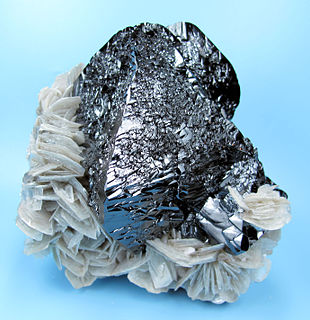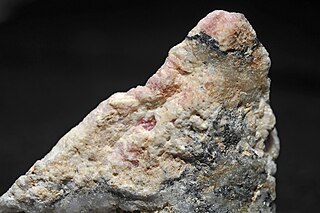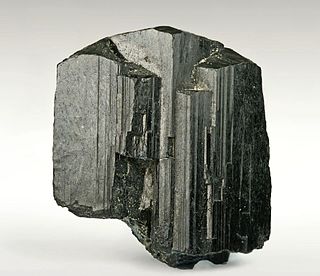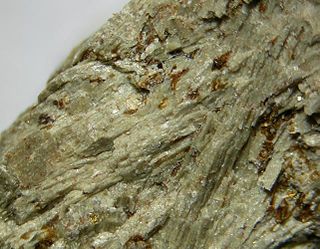
Kogarkoite is a sodium sulfate fluoride mineral with formula Na3(SO4)F. It has a pale blue color, a specific gravity of about 2.67 and a hardness of 3.5. The crystal is monoclinic and is a type of naturally occurring antiperovskite. Kogarkoite is named after the Russian petrologist Lia Nikolaevna Kogarko (born 1936) who discovered the mineral.

Cassiterite is a tin oxide mineral, SnO2. It is generally opaque, but it is translucent in thin crystals. Its luster and multiple crystal faces produce a desirable gem. Cassiterite was the chief tin ore throughout ancient history and remains the most important source of tin today.

Tugtupite is a beryllium aluminium tectosilicate. It also contains sodium and chlorine and has the formula Na4AlBeSi4O12Cl. Tugtupite is a member of the silica-deficient feldspathoid mineral group. It occurs in high alkali intrusive igneous rocks.

Natrolite is a tectosilicate mineral species belonging to the zeolite group. It is a hydrated sodium and aluminium silicate with the formula Na2Al2Si3O10 • 2H2O. The type locality is Hohentwiel, Hegau, Germany.

Eudialyte, whose name derives from the Greek phrase Εὖ διάλυτος eudialytos, meaning "well decomposable", is a somewhat rare, nine member ring cyclosilicate mineral, which forms in alkaline igneous rocks, such as nepheline syenites. Its name alludes to its ready solubility in acid.

Arfvedsonite is a sodium amphibole mineral with composition: [Na][Na2][(Fe2+)4Fe3+][(OH)2|Si8O22]. It crystallizes in the monoclinic prismatic crystal system and typically occurs as greenish black to bluish grey fibrous to radiating or stellate prisms.

Aegirine is a member of the clinopyroxene group of inosilicate minerals. Aegirine is the sodium endmember of the aegirine-augite series. Aegirine has the chemical formula NaFeSi2O6 in which the iron is present as Fe3+. In the aegirine-augite series the sodium is variably replaced by calcium with iron(II) and magnesium replacing the iron(III) to balance the charge. Aluminium also substitutes for the iron(III). Acmite is a fibrous, green-colored variety.

Alexander Evgenʹevich Fersman was a prominent Soviet Russian geochemist and mineralogist, and a member of the Soviet Academy of Sciences (1919–1945).

Nenadkevichite is a rare silicate mineral containing niobium with formula: (Na,Ca)(Nb,Ti)Si2O7·2H2O. It forms brown to yellow to rose colored orthorhombic dipyramidal crystals with a dull to earthy luster. It has a Mohs hardness of 5 and a specific gravity of 2.86.
Nyerereite is a very rare sodium calcium carbonate mineral with formula Na2Ca(CO3)2. It forms colorless, platey pseudohexagonal orthorhombic crystals that are typically twinned. It has a specific gravity of 2.54 and indices of refraction of nα=1.511, nβ=1.533 and nγ=1.535. Nyerereite is not stable in contact with the atmosphere and rapidly breaks down. Collection specimens must be kept in a sealed argon environment.

Lorenzenite is a rare sodium titanium silicate mineral with the formula Na2Ti2Si2O9 It is an orthorhombic mineral, variously found as colorless, grey, pinkish, or brown crystals.

Cafetite is a rare titanium oxide mineral with formula (Ca,Mg)(Fe,Al)
2Ti
4O
12·4(H
2O). It is named for its composition, Ca-Fe-Ti.

Aliettite is a complex phyllosilicate mineral of the smectite group with a formula of (Ca0.2Mg6(Si,Al)8O20(OH)4·4H2O) or [Mg3Si4O10(OH)2](Ca0.5,Na)0.33(Al,Mg,Fe2+)2–3(Si,Al)4O10(OH)2·n(H2O).

Loparite-(Ce) is a granular, brittle oxide mineral of the perovskite class. It is black to dark grey and may appear grey to white in reflected light on polished thin section with reddish brown internal reflections. It has the chemical formula of (Ce,Na,Ca)(Ti,Nb)O3. Nioboloparite is a variation of Loparite-(Ce) containing niobium.

Perovskite (pronunciation: ) is a calcium titanium oxide mineral composed of calcium titanate (CaTiO3). Its name is also applied to the class of compounds which have the same type of crystal structure as CaTiO3 (XIIA2+VIB4+X2−3), known as the perovskite structure. Many different cations can be embedded in this structure, allowing the development of diverse engineered materials.
Altisite is an exceedingly rare alkaline titanium aluminosilicate chloride mineral with formula Na3K6Ti2Al2Si8O26Cl3, from alkaline pegmatites. It is named after its composition (ALuminium, TItanium, and SIlicon).
Eveslogite is a complex inosilicate mineral with a chemical formula (Ca,K,Na,Sr,Ba)
48[(Ti,Nb,Fe,Mn)
12(OH)
12Si
48O
144](F,OH,Cl)
14 found on Mt. Eveslogchorr in Khibiny Mountains, on the Kola peninsula, Russia. It was named after the place it was found. This silicate mineral occurs as an anchimonomineral veinlet that cross-cuts poikilitic nepheline syenite. This mineral appears to resemble yuksporite, as it forms similar placated fine fibrous of approximately 0.05 to 0.005mm that aggregates outwardly. The color of eveslogite is yellow or rather light brown. In addition, it is a semitransparent mineral that has a white streak and a vitreous luster. Its crystal system is monoclinic and possesses a hardness (Mohs) of 5. This newly discovered mineral belongs to the astrophyllite group of minerals and contains structures that are composed of titanosilicate layers. Limited information about this mineral exists due to the few research studies carried out since its recent discovery.

Kovdorskite, Mg2PO4(OH)·3H2O, is a rare, hydrated, magnesium phosphate mineral. It was first described by Kapustin et al., and is found only in the Kovdor Massif near Kovdor, Kola Peninsula, Russia. It is associated with collinsite, magnesite, dolomite, hydrotalcite, apatite, magnetite, and forsterite.
Ekplexite is a unique sulfide-hydroxide niobium-rich mineral with the formula (Nb,Mo)S
2•(Mg
1-xAl
x)(OH)
2+x. It is unique because niobium is usually found in oxide or, eventually, silicate minerals. Ekplexite is a case in which chalcophile behaviour of niobium is shown, which means niobium present in a sulfide mineral. The unique combination of elements in ekplexite has to do with its name, which comes from a Greek world on "surprise". The other example of chalcophile behaviour of niobium is edgarite, FeNb3S6, and both minerals were found in the same environment, which is a fenitic rock of Mt. Kaskasnyunchorr, Khibiny Massif, Kola Peninsula, Russia. Analysis of the same rock has revealed the presence of two analogues of ekplexite, kaskasite (molybdenum-analogue) and manganokaskasite (molybdenum- and manganese-analogue). All three minerals belong to the valleriite group, and crystallize in the trigonal system with similar possible space groups.
Cattiite is a phosphate mineral. The mineral was first found in a veins of dolomite carbonatites veins at the bottom of the Zhelezny (Iron) Mine in the Kovdor massif, Kola Peninsula, Russia. Cattiite was tentatively identified as Mg3(PO4)2 • 22H2O, which as a high hydrate magnesium orthophosphate. Later structural studies, revealed the existence of two polytypes named Mg3(PO4)2 • 22H2O-1A1 and Mg3(PO4)2 • 22H2O-1A2.















